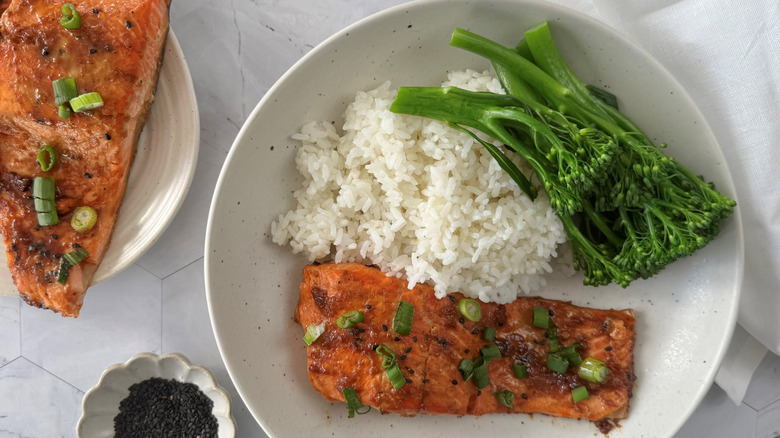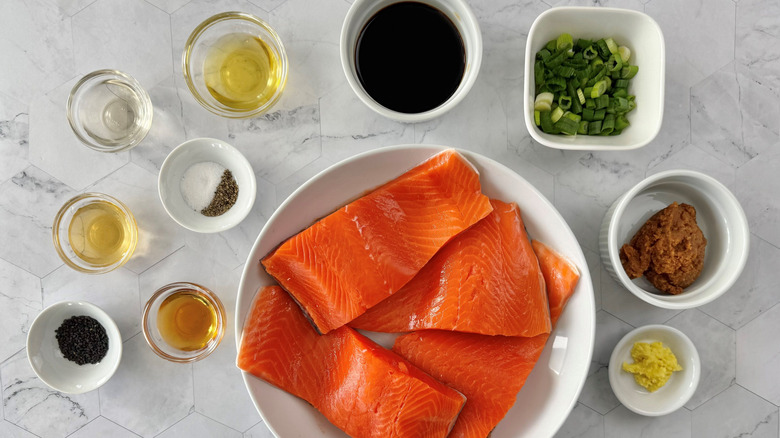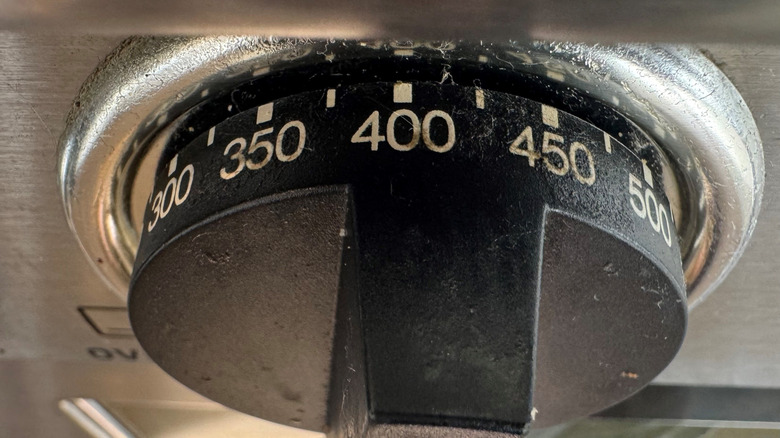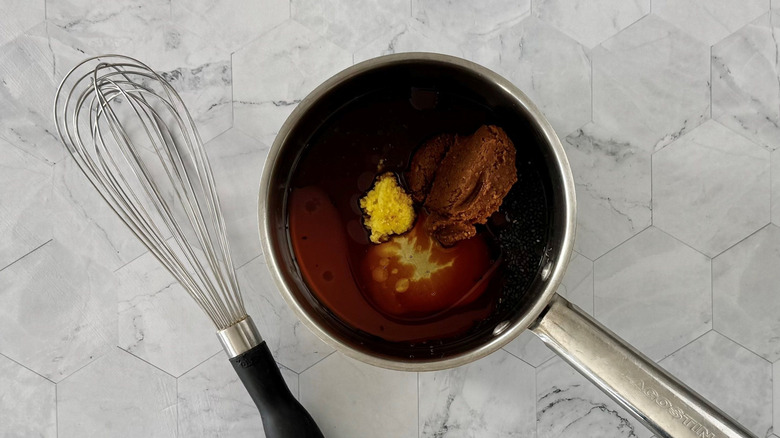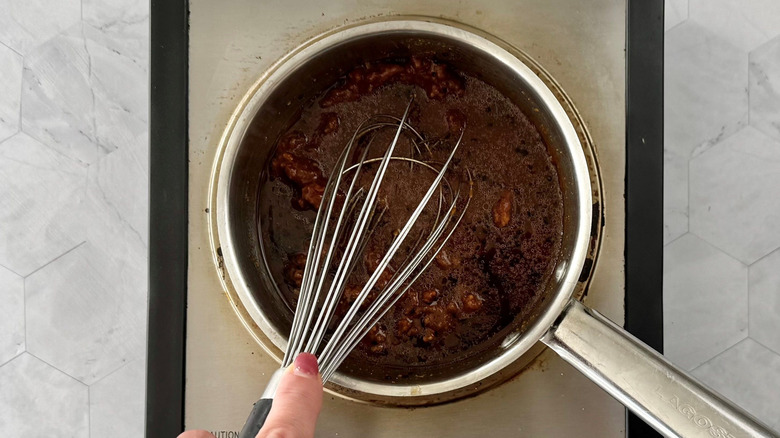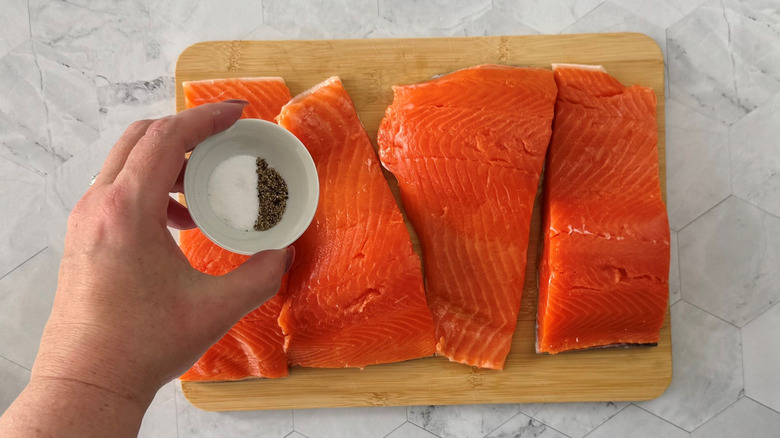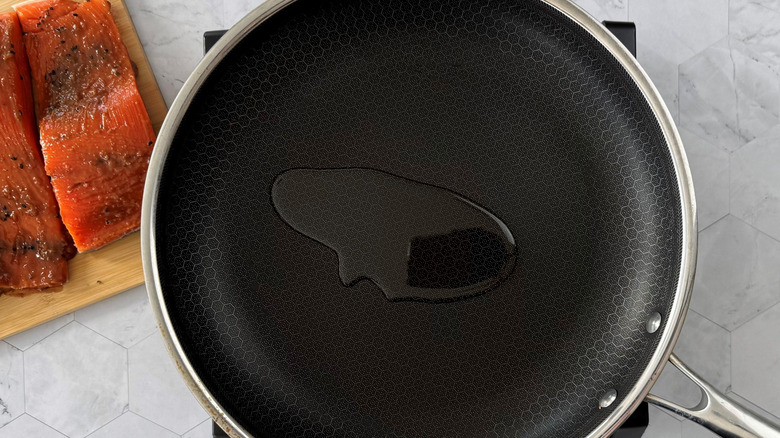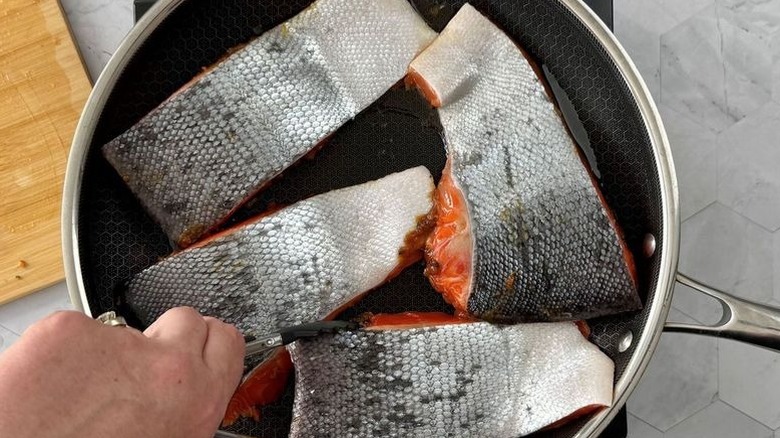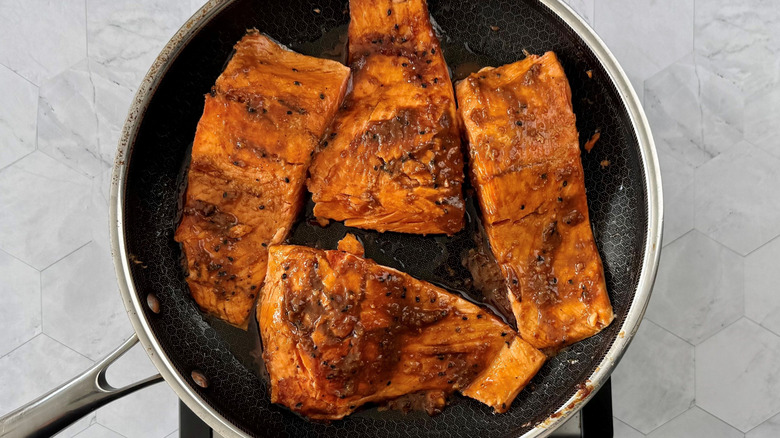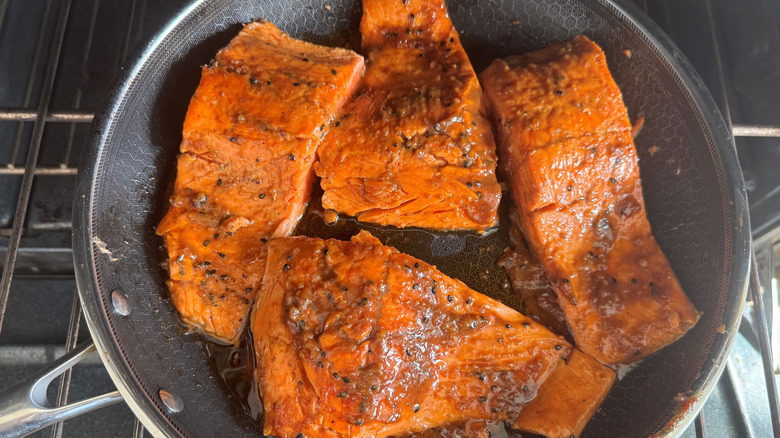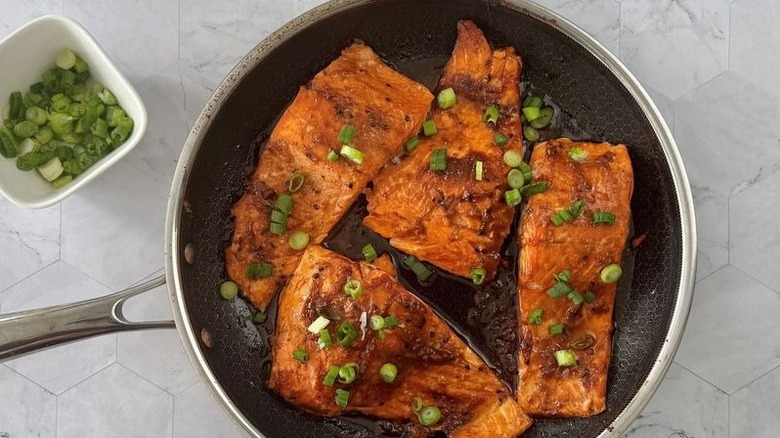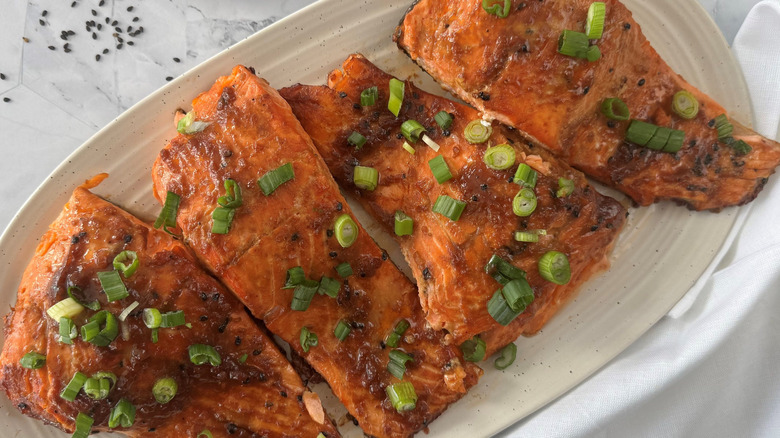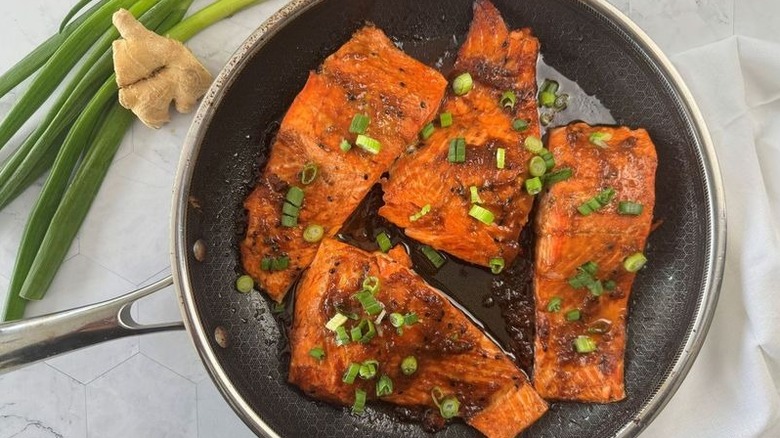Miso And Ginger-Glazed Salmon Recipe
There are seemingly endless ways to prepare salmon, and moreover, there are endless possibilities when it comes to seasoning it or dressing it up. Simple salt and pepper will do the trick in a pinch, but if you really want to give salmon ultimate flavor, umami-packed miso is the way to go. Recipe developer Julianne De Witt takes full advantage of this flavor-rich ingredient in this miso and ginger-glazed salmon recipe, a preparation that is incredibly simple, yet one that will make your weeknight dinner just a little more exciting. The glaze takes on a depth of earthy flavor from sesame oil, and the grated ginger gives it a bright zesty kick.
One thing that De Witt appreciates about this recipe is that, despite elevating simple salmon into something remarkably elegant and tasty, it's still perfect for quick weeknights when you don't have much time to plan an elaborate meal. "This vibrantly tasty salmon is so easy to prepare and can be on the table in under 20 minutes," she says. And, because the salmon itself is laden with flavor thanks to the miso and ginger glaze, you can keep the sides nice and simple so as not to overcomplicate things. "Serve this salmon with steamed sticky rice, roast potatoes, rice pilaf, and your favorite steamed veggies," De Witt recommends.
Gather the ingredients for miso and ginger-glazed salmon
You'll need four salmon filets as the base for this recipe, along with soy sauce, rice vinegar, sesame seeds, toasted sesame oil, grated ginger, miso paste, and honey for the glaze. De Witt specifically uses white miso paste here, though we'll dive a bit deeper into the difference between red and white miso and whether you can swap in red a little bit later.
You'll also need a bit of salt and pepper to season the salmon, along with avocado oil for searing the salmon in a pan before baking. Finally, you may wish to garnish the final dish with chopped scallions.
Step 1: Preheat the oven
Preheat the oven to 400 F.
Step 2: Heat the glaze
Place the soy sauce, vinegar, sesame seeds, sesame oil, ginger, miso paste, and honey in a small saucepan over medium-low heat.
Step 3: Bring the glaze together
Whisk the glaze and simmer for 2 minutes until thick. Remove from the heat.
Step 4: Season the salmon
Season the salmon lightly with salt and pepper.
Step 5: Brush glaze on salmon
Brush the glaze liberally over the salmon.
Step 6: Heat avocado oil
Add the avocado oil to a large oven-safe frying pan over medium heat.
Step 7: Brown the salmon
Place the salmon top side down and brown lightly for 2 minutes.
Step 8: Flip the salmon
Carefully flip the salmon.
Step 9: Bake the salmon
Place the salmon in the oven and bake for 10 minutes or until the salmon is firm and reaches 130 F.
Step 10: Garnish and serve
Sprinkle scallions over the salmon and serve.
Miso and Ginger-Glazed Salmon Recipe
This vibrantly tasty salmon, brushed with a flavorful miso ginger sauce, seared, and then baked for perfect tenderness, can be on the table in under 20 minutes.
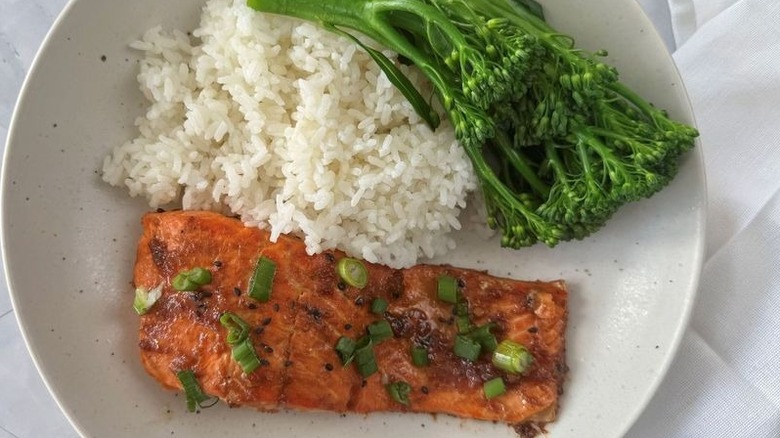
Ingredients
- ¼ cup soy sauce
- 1 tablespoon rice vinegar
- 1 teaspoon sesame seeds
- 1 tablespoon toasted sesame oil
- 1 ½ teaspoons finely grated ginger
- ¼ cup white miso paste
- 1 tablespoon honey
- 4 (6-ounce) filets salmon
- ½ teaspoon sea salt
- ½ teaspoon ground black pepper
- 1 tablespoon avocado oil
- 3 diced scallions
Directions
- Preheat the oven to 400 F.
- Place the soy sauce, vinegar, sesame seeds, sesame oil, ginger, miso paste, and honey in a small saucepan over medium-low heat.
- Whisk the glaze and simmer for 2 minutes until thick. Remove from the heat.
- Season the salmon lightly with salt and pepper.
- Brush the glaze liberally over the salmon.
- Add the avocado oil to a large oven-safe frying pan over medium heat.
- Place the salmon top side down and brown lightly for 2 minutes.
- Carefully flip the salmon.
- Place the salmon in the oven and bake for 10 minutes or until the salmon is firm and reaches 130 F.
- Sprinkle scallions over the salmon and serve.
Nutrition
| Calories per Serving | 483 |
| Total Fat | 31.2 g |
| Saturated Fat | 6.3 g |
| Trans Fat | 0.0 g |
| Cholesterol | 93.6 mg |
| Total Carbohydrates | 10.7 g |
| Dietary Fiber | 1.5 g |
| Total Sugars | 5.7 g |
| Sodium | 1,618.6 mg |
| Protein | 38.6 g |
What are some tips for cooking salmon?
To cook perfect salmon, there's some work you have to do before you even fire up a burner, and that involves choosing the right fish. De Witt notes that you can use either fresh or frozen salmon, but if you do use frozen, be sure to thaw it overnight or quickly thaw it in a cold water bath, making sure to change out the water frequently so the salmon thaws safely. She particularly enjoys coho salmon, explaining, "I like to use coho salmon for this recipe. Coho is found throughout the North Pacific Ocean and is abundant in the waters from Alaska down to Oregon. The meat of this salmon is reddish-orange in color, has a medium fat content, and is considered one of the tastiest salmon varieties." But ultimately any type of salmon will work here.
As for the actual cooking, De Witt opts for a sear-then-bake method, which is pretty foolproof. If the searing step seems too complicated, you can simply skip that step altogether and skip straight to popping the salmon in the oven. "Cooking the salmon until 130 F and allowing it to rest for a few minutes will yield a flaky, medium-cooked salmon that is moist and not overdone," De Witt says, noting that this is the temperature that most restaurants aim for. If you want your salmon a little more well-done but not overcooked, then shoot for 145 F, and consider using a meat thermometer for absolute accuracy.
What is miso paste and what does it taste like?
Miso is a type of fermented soybean paste that is a very common ingredient in Japanese and Asian cooking. Though fermented soybeans are key to miso paste, koji is another common ingredient, which generally refers to fermented grain, be it rice or barley. The resulting paste is very umami-rich, with notes of saltiness, a hint of sweetness, and possibly a little funkiness since it is a fermented ingredient. Though miso soup may be the most recognizable dish made with miso, the paste is incredibly versatile, and a little goes a long way in adding a boost of flavor to seemingly endless dishes.
You can find a few different types of miso paste, with the most common being white, red, or yellow miso. De Witt opted for white miso for this salmon recipe, explaining, "It's milder and sweeter in flavor and complements the salmon without overpowering it." Red miso, on the other hand, has a much stronger and robust flavor profile, so it would add a more-pronounced miso flavor to the salmon in this dish. That said, De Witt notes that you can swap in red miso if that's all you have on hand, or if you prefer the flavor.
